Starch Components, Starch Properties and Appearance Quality of Opaque Kernels from Rice Mutants
Abstract
1. Introduction
2. Results and Discussion
2.1. Screening Mutants with Altered Starch Components
2.2. Starch Components in Brown Kernels of Rice Mutants
2.3. Relationships between Iodine Absorption Spectrum Parameters and Starch Components
2.4. Crystalline Structure of Starches from Rice Mutants
2.5. Short-Range Ordered Structure of Starches from Rice Mutants
2.6. Thermal Properties of Starches from Rice Mutants
2.7. Appearance Quality of Brown Rice Kernels
3. Materials and Methods
3.1. Plant Materials
3.2. Isolation of Starch from Brown Rice Kernels
3.3. Determination of Starch–Iodine Absorption Spectrum
3.4. Determination of AC in Starch
3.5. Determination of Molecular Weight Distribution of Starch
3.6. Analysis of Crystalline Structure of Starch
3.7. Analysis of Short-Range Ordered Structure of Starch
3.8. Determination of Thermal Properties of Starch
3.9. Measurement of Appearance Quality of Brown Rice Kernels
3.10. Statistical Analysis
4. Conclusions
Supplementary Materials
Author Contributions
Funding
Conflicts of Interest
References
- Tian, Z.; Qian, Q.; Liu, Q.; Yan, M.; Liu, X.; Yan, C.; Liu, G.; Gao, Z.; Tang, S.; Zeng, D.; et al. Allelic Diversities in Rice Starch Biosynthesis Lead to A Diverse Array of Rice Eating and Cooking Qualities. Proc. Natl. Acad. Sci. USA 2009, 22, 21760–21765. [Google Scholar] [CrossRef] [PubMed]
- Umemoto, T.; Horibata, T.; Aoki, N.; Hiratsuka, M.; Yano, M.; Inouchi, N. Effects of Variations in Starch Synthase on Starch Properties and Eating Quality of Rice. Plant. Prod. Sci. 2008, 11, 472–480. [Google Scholar] [CrossRef]
- Fan, X.Y.; Guo, M.; Li, R.D.; Yang, Y.H.; Liu, M.; Zhu, Q.; Tang, S.Z.; Gu, M.H.; Xu, R.G.; Yan, C.J. Allelic Variations in the Soluble Starch Synthase II Gene Family Result in Changes of Grain Quality and Starch Properties in Rice (Oryza sativa L.). J. Agric. Sci. 2017, 155, 129–140. [Google Scholar] [CrossRef]
- Lin, L.; Guo, K.; Zhang, L.; Zhang, C.; Liu, Q.; Wei, C. Effects of Molecular Compositions on Crystalline Structure and Functional Properties of Rice Starches with Different Amylopectin Extra-Long Chains. Food. Hydrocolloid. 2019, 88, 137–145. [Google Scholar] [CrossRef]
- Lin, L.; Pan, T.; Liu, Q.; Wei, C. Cooking, Morphological, Mechanical and Digestion Properties of Cooked Rice with Suppression of Starch Branching Enzymes. Int. J. Biol. Macromol. 2019, 137, 187–196. [Google Scholar] [CrossRef]
- Kumar, I.; Khush, G.S. Genetic Analysis of Different Amylose Levels in Rice. Crop. Sci. 1987, 27, 1167–1172. [Google Scholar] [CrossRef]
- Noda, T.; Nishiba, Y.; Sato, T.; Suda, I. Properties of Starches from Several Low-Amylose Rice Cultivars. Cereal. Chem. 2003, 80, 193–197. [Google Scholar] [CrossRef]
- Li, Q.F.; Huang, L.C.; Chu, R.; Li, J.; Jiang, M.Y.; Zhang, C.Q.; Fan, X.L.; Yu, H.X.; Gu, M.H.; Liu, Q.Q. Down-Regulation of SSSII-2 Gene Expression Results in Novel Low-Amylose Rice with Soft, Transparent Grains. J. Agric. Food. Chem. 2018, 66, 9750–9760. [Google Scholar] [CrossRef]
- Tao, K.; Yu, W.; Prakash, S.; Gilbert, R.G. High-Amylose Rice: Starch Molecular Structural Features Controlling Cooked Rice Texture and Preference. Carbohyd. Polym. 2019, 219, 251–260. [Google Scholar] [CrossRef]
- Zhu, L.; Gu, M.; Meng, X.; Cheung, S.C.K.; Yu, H.; Huang, J.; Sun, Y.; Shi, Y.; Liu, Q. High-Amylose Rice Improves Indices of Animal Health in Normal and Diabetic Rats. Plant. Biotechnol. J. 2012, 10, 353–362. [Google Scholar] [CrossRef]
- Satoh, H.S.; Nishi, A.; Fujita, N.; Kubo, A.; Nakamura, Y.; Kawasaki, T.; Okita, T.W. Isolation and Characterization of Starch Mutants in Rice. J. Appl. Glycosci. 2003, 50, 225–230. [Google Scholar] [CrossRef]
- Wang, Y.H.; Liu, F.; Ren, Y.L.; Wang, Y.; Liu, X.; Long, W.; Wang, D.; Zhu, J.; Zhu, X.; Jing, R.; et al. GOLGI TRANSPORT 1B Regulates Protein Export from the Endoplasmic Reticulum in Rice Endosperm Cells. Plant. Cell. 2016, 28, 2850–2865. [Google Scholar] [CrossRef] [PubMed]
- Ren, Y.L.; Wang, Y.H.; Liu, F.; Zhou, K.; Ding, Y.; Zhou, F.; Wang, Y.; Liu, K.; Gan, L.; Ma, W.; et al. GLUTELIN PRECURSOR ACCUMULATION3 Encodes a Regulator of Post-Golgi Vesicular Traffic Essential for Vacuolar Protein Sorting in Rice Endosperm. Plant. Cell. 2014, 26, 410–425. [Google Scholar] [CrossRef] [PubMed]
- Liu, J.; Wu, X.; Yao, X.; Yu, R.; Larkin, P.J.; Liu, C.M. Mutations in the DNA Demethylase OsROS1 Result in a Thickened Aleurone and Improved Nutritional Value in Rice Grains. Proc. Natl. Acad. Sci. USA 2018, 115, 11327–11332. [Google Scholar] [CrossRef] [PubMed]
- Nakagami, T.; Yoshihara, H.; Nakamura, T.; Utsumi, Y.; Sawada, T.; Fujita, N.; Satoh, H.; Nakamura, Y. Biochemical Analysis of New-Type Mutants of Japonica Rice that Accumulate Water-Soluble α-glucans in the Endosperm but Retain Full Starch Debranching Enzyme Activities. Starch 2017, 69, 1600159. [Google Scholar] [CrossRef]
- Asai, H.; Abe, N.; Matsushima, R.; Crofts, N.; Oitome, N.F.; Nakamura, Y.; Fujita, N. Deficiencies in Both Starch Synthase IIIa and Branching Enzyme IIb Lead to a Significant Increase in Amylose in SSIIa-Inactive Japonica Rice Seeds. J. Exp. Bot. 2014, 65, 5497–5507. [Google Scholar] [CrossRef] [PubMed]
- Lee, S.K.; Hwang, S.K.; Han, M.; Eom, J.S.; Kang, H.G.; Han, Y.; Choi, S.B.; Cho, M.H.; Bhoo, S.H.; An, G.; et al. Identification of the ADP-glucose Pyrophosphorylase Isoforms Essential for Starch Synthesis in the Leaf and Seed Endosperm of Rice (Oryza sativa L.). Plant. Mol. Biol. 2007, 65, 531–546. [Google Scholar] [CrossRef]
- Wang, J.C.; Xu, H.; Zhu, Y.; Liu, Q.Q.; Cai, X.L. OsbZIP58, A Basic Leucine Zipper Transcription Factor, Regulates Starch Biosynthesis in Rice Endosperm. J. Exp. Bot. 2013, 64, 3453–3466. [Google Scholar] [CrossRef]
- Lin, L.; Zhang, Q.; Zhang, L.; Wei, C. Evaluation of the Molecular Structural Parameters of Normal Rice Starch and their Relationships with its Thermal and Digestion Properties. Molecules 2017, 22, 1526. [Google Scholar] [CrossRef]
- Agasimani, S.; Selvakumar, G.; Joel, A.J.; Ram, S.G. A Simple and Rapid Single Kernel Screening Method To Estimate Amylose Content in Rice Grains. Phytochem. Anal. 2013, 24, 569–573. [Google Scholar] [CrossRef]
- Liu, L.; Ma, X.; Liu, S.; Zhu, C.; Jiang, L.; Wang, Y.; Shen, Y.; Ren, Y.; Dong, H.; Chen, L.; et al. Identification and Characterization of a Novel Waxy Allele from a Yunnan Rice Landrace. Plant. Mol. Biol. 2009, 71, 609–626. [Google Scholar] [CrossRef] [PubMed]
- Shahid, S.; Begum, R.; Razzaque, S.; Seraj, Z.I. Variability in Amylose Content of Bangladeshi Rice Cultivars due to Unique SNPs in Waxy Allele. J. Cereal. Sci. 2016, 71, 1–9. [Google Scholar] [CrossRef]
- Wang, Y.J.; White, P.; Pollak, L.; Jane, J. Characterization of Starch Structures of 17 Maize Endosperm Mutant Genotypes with Oh43 Inbred Line Background. Cereal. Chem. 1993, 70, 171. [Google Scholar]
- Crofts, N.; Abe, N.; Oitome, N.F.; Matsushima, R.; Hayashi, M.; Tetlow, I.J.; Emes, M.J.; Nakamura, Y.; Fujita, N. Amylopectin Biosynthetic Enzymes from Developing Rice Seed Form Enzymatically Active Protein Complexes. J. Exp. Bot. 2015, 66, 4469–4482. [Google Scholar] [CrossRef] [PubMed]
- Crofts, N.; Lizuka, Y.; Abe, N.; Miura, S.; Kikuchi, K.; Matsushima, R.; Fujita, N. Rice Mutants Lacking Starch Systhase I or Branching Enzyme IIb Activity Altered Starch Biosynthetic Protein Complexes. Front. Plant. Sci. 2018, 9, 1817. [Google Scholar] [CrossRef]
- Cheetham, N.W.H.; Tao, L. Variation in Crystalline Type with Amylose Content in Maize Starch Granules: An X-ray Powder Diffraction Study. Carbohyd. Polym. 1998, 36, 277–284. [Google Scholar] [CrossRef]
- He, W.; Wei, C. Progress in C-type starches from different plant sources. Food. Hydrocolloid. 2017, 73, 162–175. [Google Scholar] [CrossRef]
- Dries, D.M.; Gomand, S.V.; Delcour, J.A.; Goderis, B. V-type Crystal Formation in Starch by Aqueous Ethanol Treatment: The effect of amylose degree of polymerization. Food. Hydrocolloid. 2016, 61, 649–661. [Google Scholar] [CrossRef]
- Wang, J.; Hu, P.; Chen, Z.; Liu, Q.; Wei, C. Progress in High-Amylose Cereal Crops through Inactivation of Starch Branching Enzymes. Front. Plant. Sci. 2017, 8, 469. [Google Scholar] [CrossRef]
- Cai, J.; Man, J.; Huang, J.; Liu, Q.; Wei, X.; Wei, C. Relationship between Structure and Functional Properties of Normal Rice Starches with Different Amylose Contents. Carbohyd. Polym. 2015, 125, 35–44. [Google Scholar] [CrossRef]
- Atichokudomchai, N.; Varavinit, S.; Chinachoti, P. A Study of Ordered Structure in Acid-Modified Tapioca Starch by 13C CP/MAS Solid-State NMR. Carbohyd. Polym. 2004, 58, 383–389. [Google Scholar] [CrossRef]
- Sevenou, O.; Hill, S.E.; Farhat, I.A.; Mitchell, J.R. Organisation of the External Region of the Starchgranule as Determined by Infrared Spectroscopy. Int. J. Biol. Macromol. 2002, 31, 79–85. [Google Scholar] [CrossRef]
- Park, I.M.; Ibáñez, A.M.; Zhang, F.; Shoemaker, C.F. Gelatinization and Pasting Properties of Waxy and Non-Waxy Rice Starches. Starch 2007, 59, 388–396. [Google Scholar] [CrossRef]
- Chung, H.J.; Liu, Q.; Lee, L.; Wei, D. Relationship between the Structure, Physicochemical Properties and in vitro Digestibility of Rice Starches with Different Amylose Contents. Food. Hydrocolloid. 2011, 25, 968–975. [Google Scholar] [CrossRef]
- Kubo, A.; Akdogan, G.; Nakaya, M.; Shojo, A.; Suzuki, S.; Satoh, H.; Kitamura, S. Structure, Physical, and Digestive Properties of Starch from wx ae Double-Mutant Rice. J. Agric. Food. Chem. 2010, 58, 4463–4469. [Google Scholar] [CrossRef]
- Zhu, L.J.; Liu, Q.Q.; Wilson, J.D.; Gu, M.H.; Shi, Y.C. Digestibility and Physicochemical Properties of Rice (Oryza sativa L.) Flours and Starches Differing in Amylose Content. Carbohyd. Polym. 2011, 86, 1751–1759. [Google Scholar] [CrossRef]
- Teng, B.; Zhang, Y.; Du, S.; Wu, J.; Li, Z.; Luo, Z.; Yang, J. Crystalline, Thermal and Swelling Properties of Starches from Single-Segment Substitution Lines with Different Wx Alleles in Rice (Oryza sativa L.). J. Sci. Food. Agric. 2017, 97, 108–114. [Google Scholar] [CrossRef]
- Cai, J.; Cai, C.; Man, J.; Zhou, W.; Wei, C. Structural and Functional Properties of C-type Starches. Carbohyd. Polym. 2014, 101, 289–300. [Google Scholar] [CrossRef]
- Yamin, F.F.; Lee, M.; Pollak, L.M.; White, P.J. Thermal Properties of Starch in Corn Variants Isolated after Chemical Mutagenesis of Inbred Lines B73. Cereal. Chem. 1999, 76, 175–181. [Google Scholar] [CrossRef]
- Lin, B.N.; Hsu, Y.C.; Kuo, S.C.; Lin, Y.R.; Wu, Y.P.; Kuo, C.W. Novel Wx Alleles Induced by Chemical Mutagens in Rice, Oryza sativa L. Plant. Breeding. 2017, 136, 206–213. [Google Scholar] [CrossRef]
- Zhang, L.; Zhao, L.; Zhang, J.; Cai, X.; Liu, Q.; Wei, C. Relationships between Transparency, Amylose Content, Starch Cavity, and Moisture of Brown Rice Kernels. J. Cereal. Sci. 2019, 90, 102854. [Google Scholar] [CrossRef]
- Wu, Y.; Pu, C.; Lin, H.; Huang, H.; Huang, Y.; Hong, C.; Chang, M.; Lin, Y. Three Novel Alleles of FLOURY ENDOSPERM2 (FLO2) Confer Dull Grains with Low Amylose Content in Rice. Plant. Sci. 2015, 233, 44–52. [Google Scholar] [CrossRef]
- Zhang, L.; Zhao, L.; Lin, L.; Zhao, L.; Liu, Q.; Wei, C. A Novel Mutation of OsPPDKB, Encoding Pyruvate Orthophosphate Dikinase, Affects Metabolism and Structure of Starch in the Rice Endosperm. Int. J. Mol. Sci. 2018, 19, 2268. [Google Scholar] [CrossRef] [PubMed]
Sample Availability: Samples of the starches are available from the authors. |
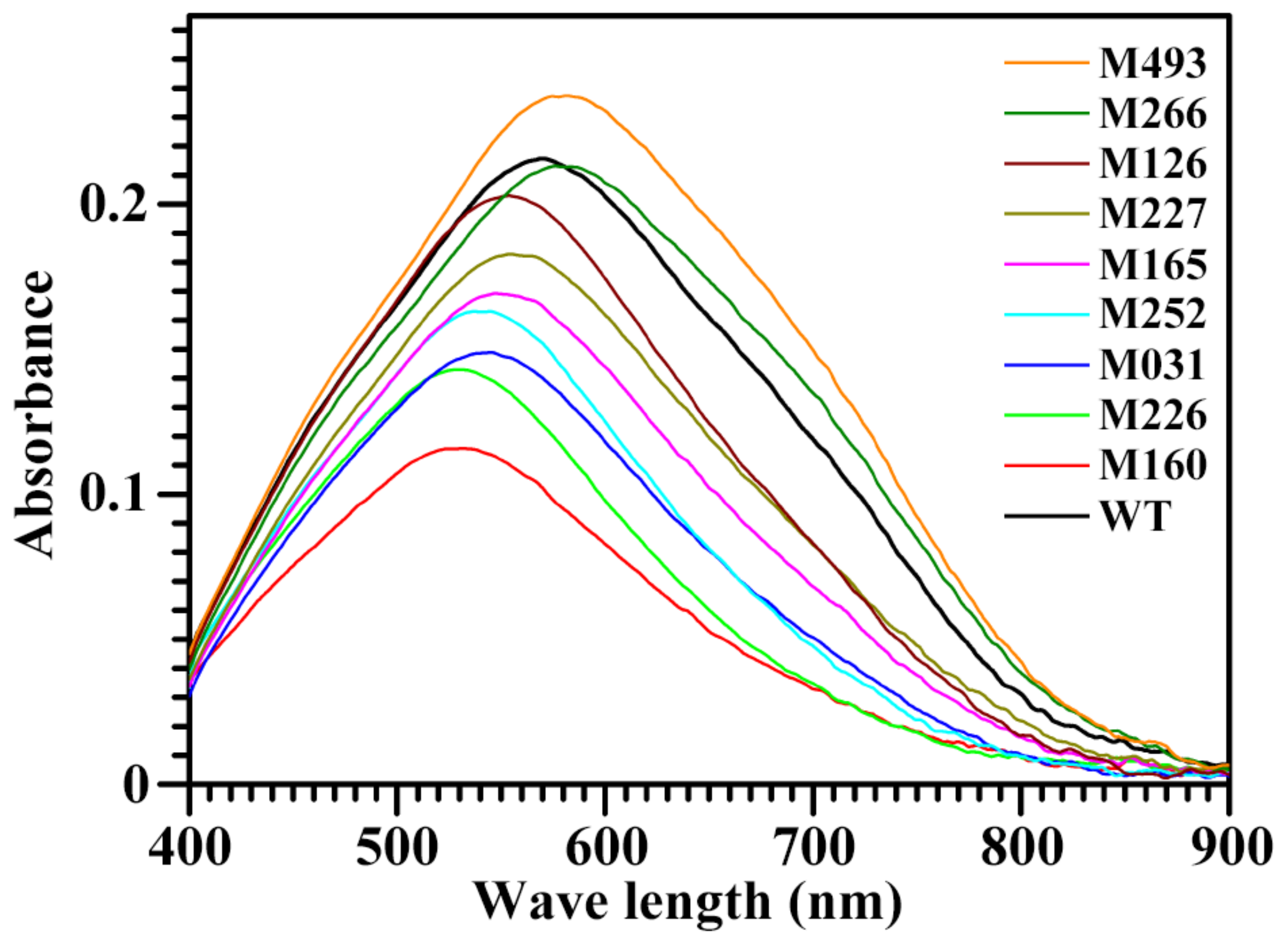
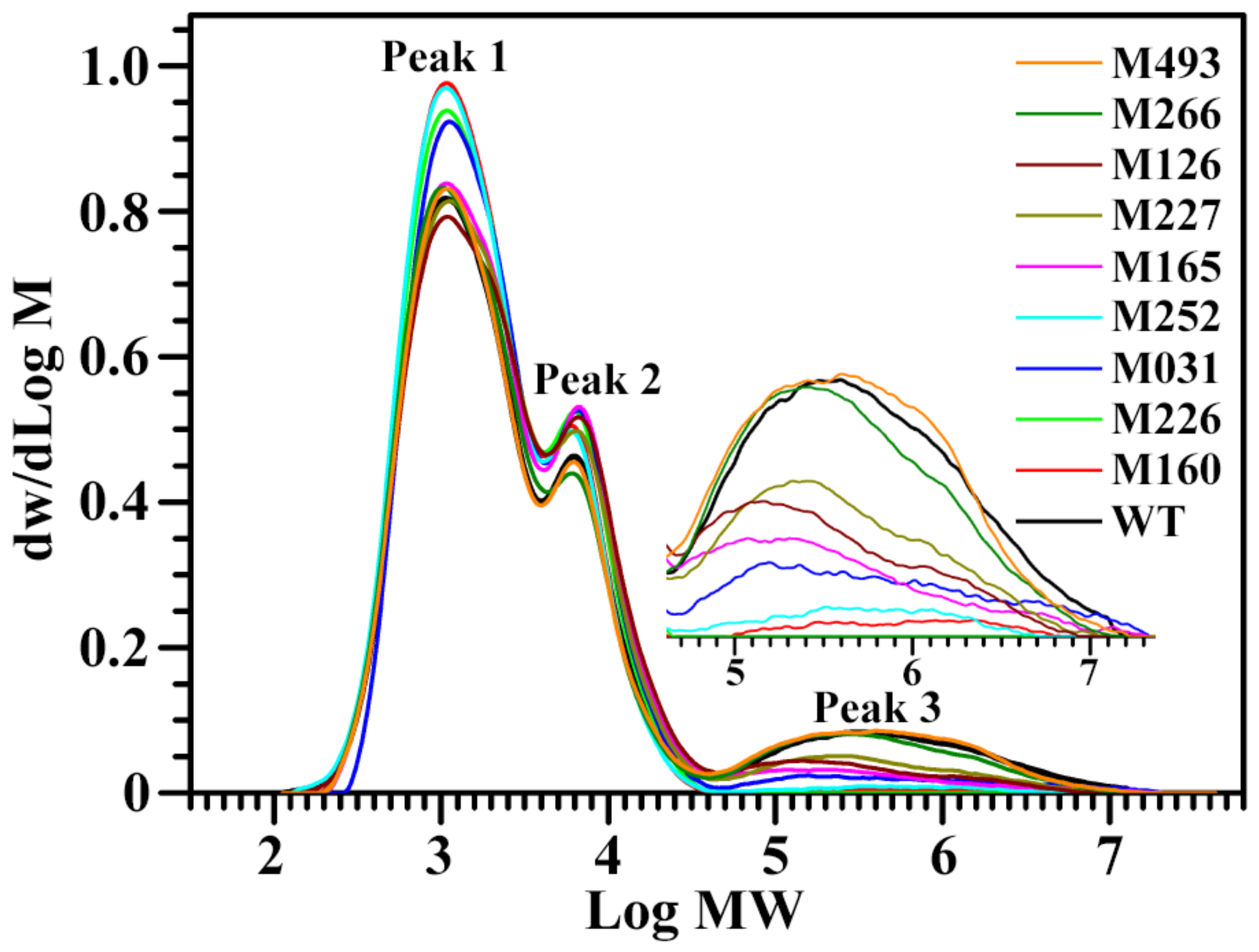
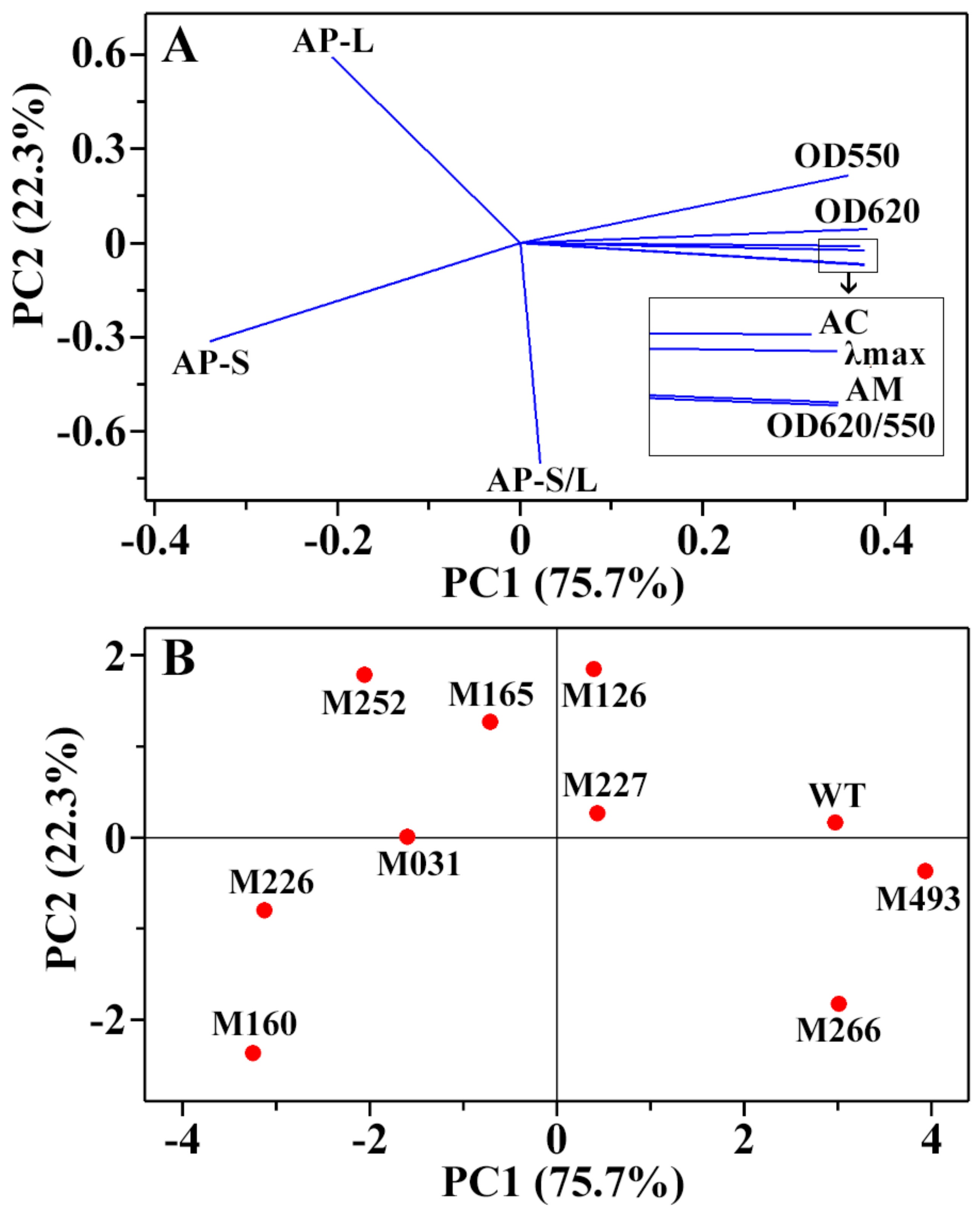
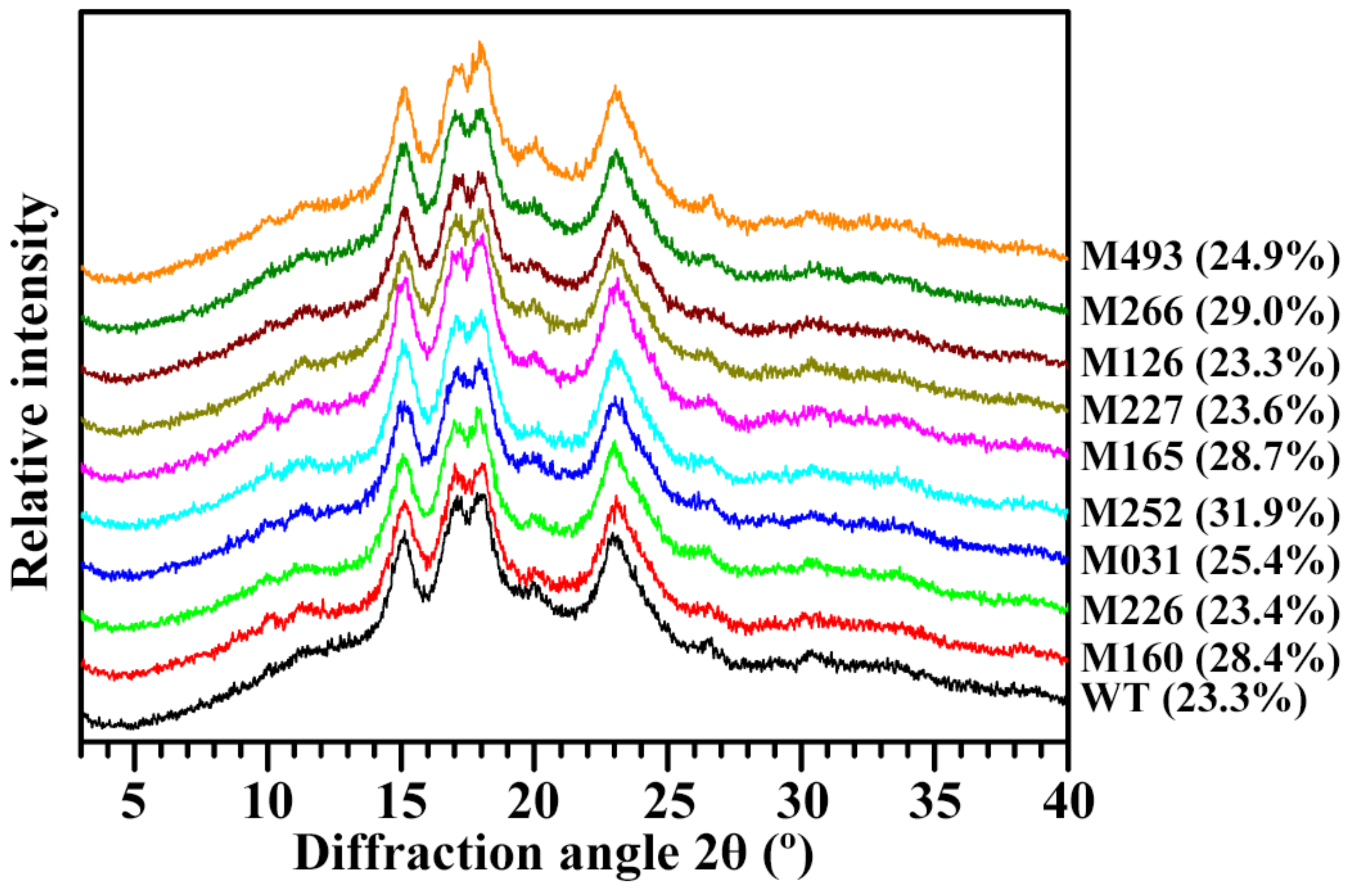
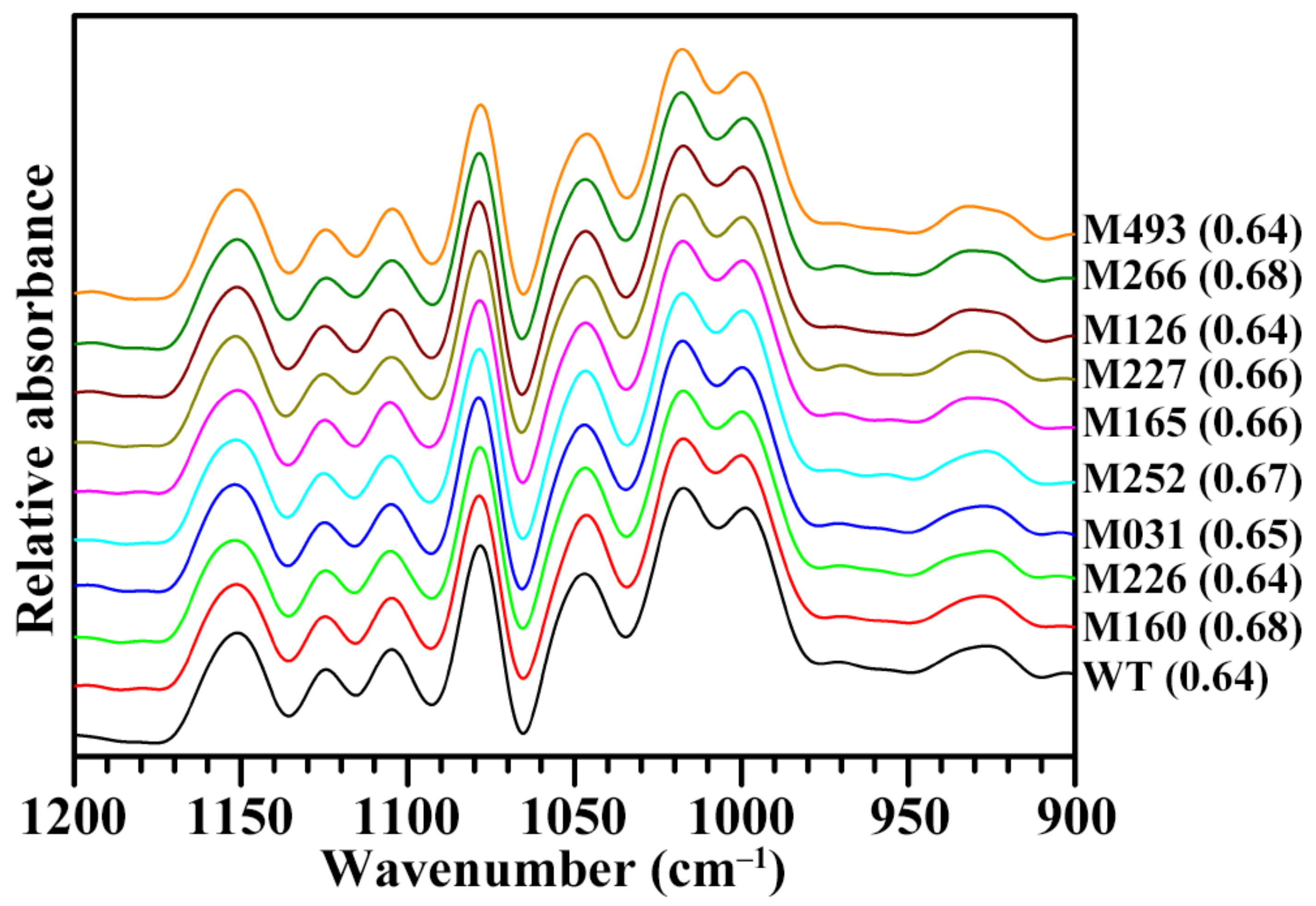
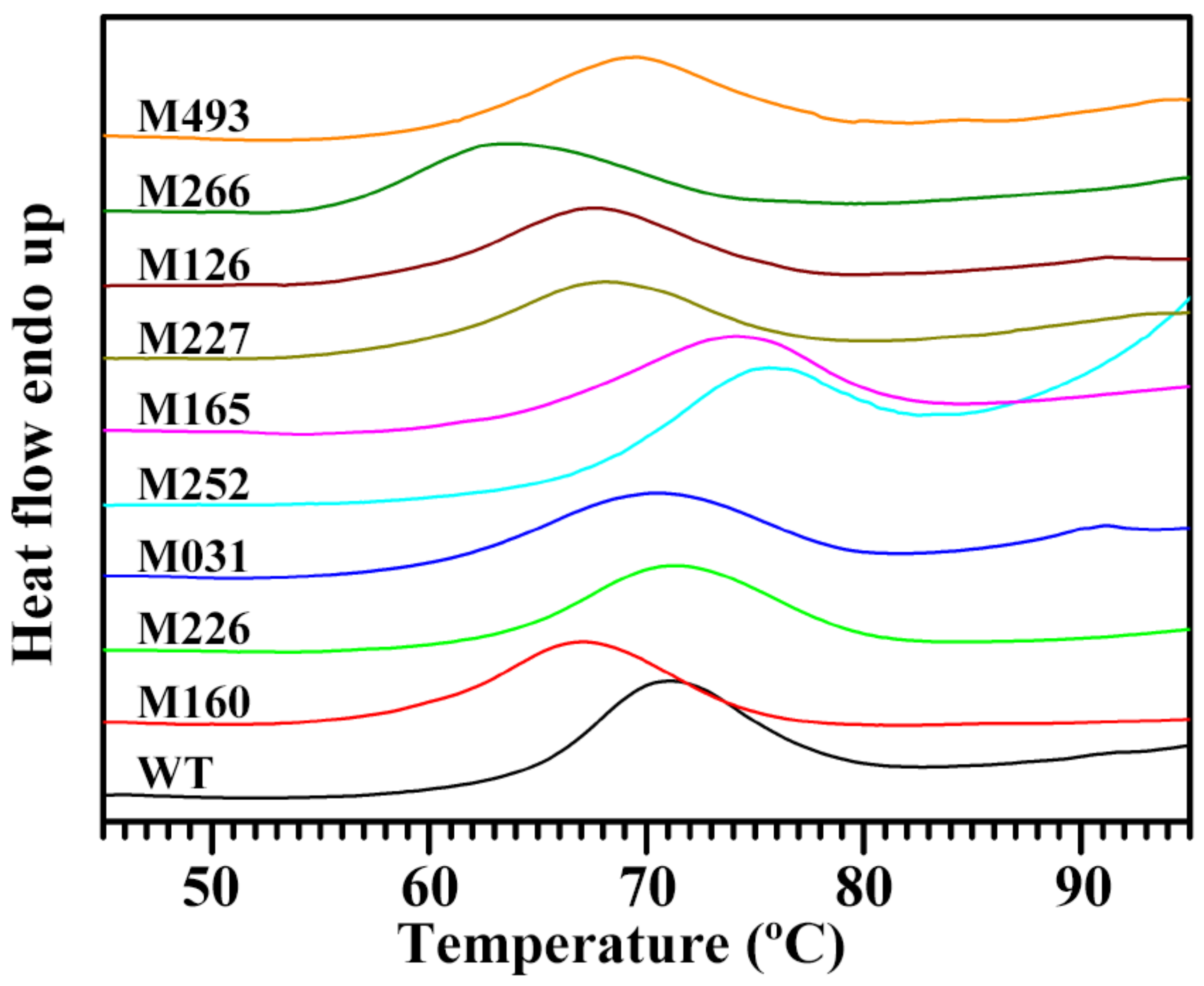
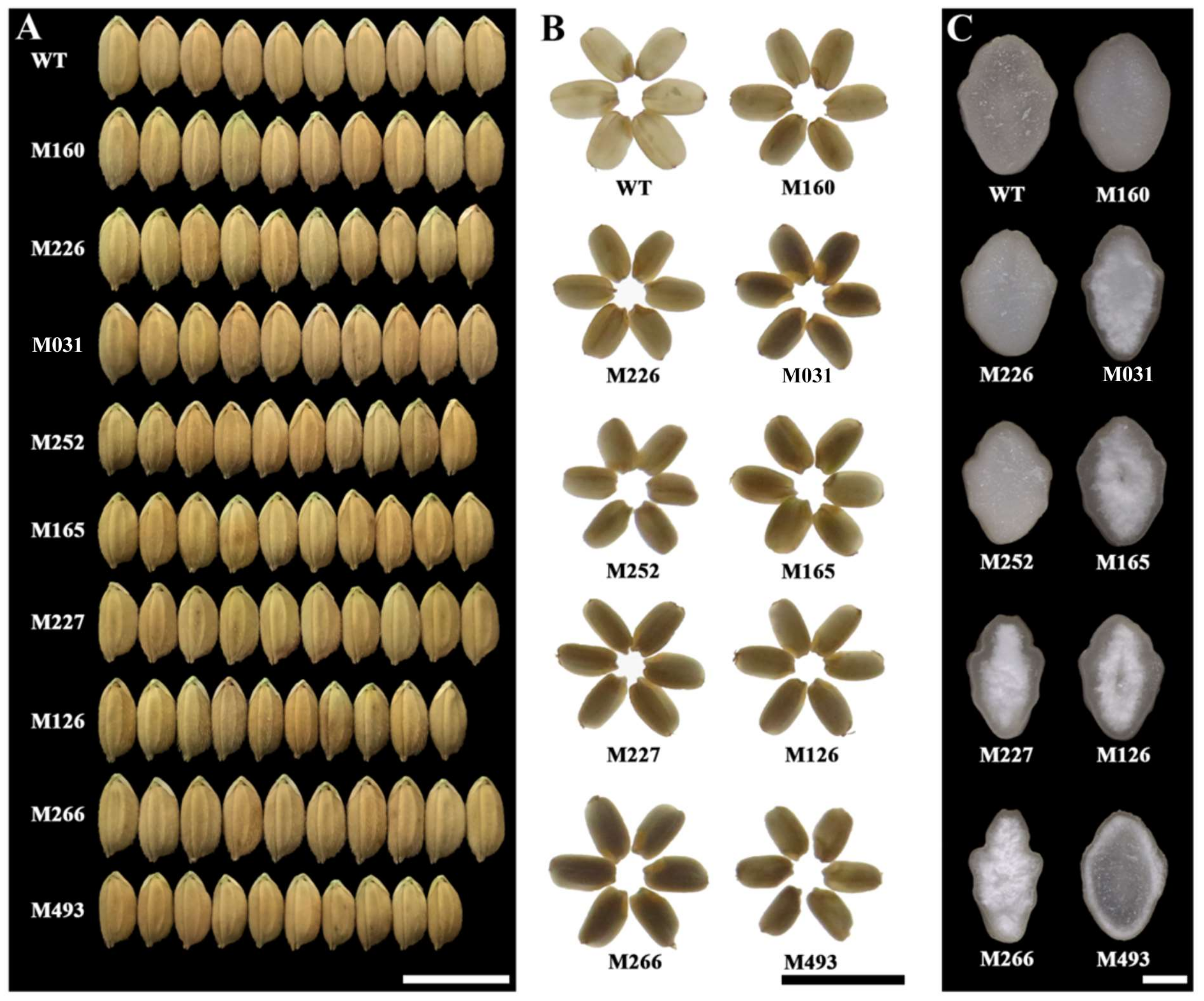
| Rice Materials | OD620 | OD550 | OD620/OD550 | λmax (nm) |
|---|---|---|---|---|
| WT | 0.188 ± 0.004e | 0.210 ± 0.009f | 0.89 ± 0.02g | 568.2 ± 1.0e |
| M160 | 0.071 ± 0.006a | 0.112 ± 0.009a | 0.63 ± 0.00b | 529.8 ± 0.7a |
| M226 | 0.082 ± 0.009a | 0.137 ± 0.015b | 0.60 ± 0.00a | 529.5 ± 1.8a |
| M031 | 0.102 ± 0.007b | 0.148 ± 0.012bc | 0.69 ± 0.01d | 542.7 ± 2.5b |
| M252 | 0.107 ± 0.003b | 0.162 ± 0.006cd | 0.66 ± 0.01c | 540.4 ± 0.5b |
| M165 | 0.127 ± 0.005c | 0.169 ± 0.007cd | 0.75 ± 0.01e | 549.9 ± 0.3c |
| M227 | 0.145 ± 0.007d | 0.182 ± 0.010de | 0.80 ± 0.01f | 557.6 ± 4.0d |
| M126 | 0.154 ± 0.003d | 0.202 ± 0.003ef | 0.76 ± 0.00e | 552.8 ± 0.6cd |
| M266 | 0.195 ± 0.009e | 0.202 ± 0.010ef | 0.97 ± 0.01h | 579.7 ± 1.9f |
| M493 | 0.219 ± 0.007f | 0.224 ± 0.010f | 0.98 ± 0.02h | 579.5 ± 3.5f |
| Rice Materials | AC (%) | AP-S (%) | AP-L (%) | AM (%) | AP-S/L |
|---|---|---|---|---|---|
| WT | 13.3 ± 0.2f | 63.9 ± 0.5a | 23.3 ± 0.5b | 12.8 ± 0.0e | 2.75 ± 0.08b |
| M160 | 2.2 ± 0.1a | 75.8 ± 0.1e | 23.1 ± 0.0b | 1.1 ± 0.1a | 3.29 ± 0.01d |
| M226 | 3.0 ± 0.2ab | 74.6 ± 0.2e | 25.4 ± 0.2c | 0.0 ± 0.0a | 2.94 ± 0.03c |
| M031 | 4.1 ± 0.4b | 70.4 ± 0.3d | 25.6 ± 0.4c | 4.0 ± 0.1b | 2.74 ± 0.05b |
| M252 | 3.2 ± 0.1ab | 69.6 ± 0.6cd | 29.1 ± 0.0e | 1.3 ± 0.6a | 2.39 ± 0.02a |
| M165 | 5.3 ± 0.4c | 68.1 ± 0.1bc | 27.4 ± 0.0d | 4.5 ± 0.1b | 2.48 ± 0.00a |
| M227 | 6.2 ± 0.6c | 67.5 ± 0.7b | 24.9 ± 0.3c | 7.6 ± 1.0d | 2.71 ± 0.00b |
| M126 | 8.2 ± 0.3d | 66.4 ± 0.2b | 27.7 ± 0.1d | 5.9 ± 0.0c | 2.40 ± 0.02a |
| M266 | 10.7 ± 0.5e | 67.3 ± 0.9b | 20.8 ± 0.5a | 11.9 ± 0.4e | 3.23 ± 0.13d |
| M493 | 14.3 ± 0.4f | 64.7 ± 0.5a | 22.4 ± 0.2b | 13.0 ± 0.3e | 2.89 ± 0.05bc |
| OD620 | OD550 | OD620/550 | λmax | AC | AP-S | AP-L | AM | |
|---|---|---|---|---|---|---|---|---|
| OD550 | 0.964 ** | |||||||
| OD620/550 | 0.975 ** | 0.890 ** | ||||||
| λmax | 0.981 ** | 0.913 ** | 0.995 ** | |||||
| AC | 0.967 ** | 0.919 ** | 0.938 ** | 0.927 ** | ||||
| AP-S | −0.899 ** | −0.955 ** | −0.831 ** | −0.858 ** | −0.854 ** | |||
| AP-L | −0.474 | −0.246 | −0.606 | −0.549 | −0.539 | 0.113 | ||
| AM | 0.961 ** | 0.885 ** | 0.978 ** | 0.969 ** | 0.961 ** | −0.851 ** | −0.618 | |
| AP-S/L | −0.003 | −0.244 | 0.156 | 0.092 | 0.067 | 0.395 | −0.864 ** | 0.145 |
| Rice Materials | To (°C) | Tp (°C) | Tc (°C) | ΔT (°C) | ΔH (J/g) |
|---|---|---|---|---|---|
| WT | 64.4 ± 0.1e | 71.0 ± 0.2e | 78.1 ± 0.8c | 13.8 ± 0.8a | 10.9 ± 0.1d |
| M160 | 59.1 ± 0.1b | 67.1 ± 0.1b | 75.1 ± 0.5ab | 16.0 ± 0.6b | 9.7 ± 0.6bcd |
| M226 | 62.9 ± 0.1d | 71.3 ± 0.1e | 79.9 ± 0.3d | 17.1 ± 0.4bc | 10.4 ± 0.0cd |
| M031 | 60.2 ± 0.1c | 70.7 ± 0.3e | 79.7 ± 0.7d | 19.5 ± 0.8d | 9.3 ± 0.5abcd |
| M252 | 67.9 ± 0.2f | 75.7 ± 0.2g | 81.6 ± 0.6e | 13.8 ± 0.8a | 7.8 ± 0.3a |
| M165 | 63.6 ± 0.2d | 74.2 ± 0.0f | 81.8 ± 0.6e | 18.3 ± 0.8cd | 10.8 ± 1.0d |
| M227 | 59.2 ± 0.1b | 68.3 ± 0.1c | 77.1 ± 0.6c | 17.9 ± 0.4bcd | 8.8 ± 0.3abc |
| M126 | 59.5 ± 0.6bc | 67.9 ± 0.4c | 76.4 ± 0.1bc | 16.9 ± 0.6bc | 8.5 ± 0.8ab |
| M266 | 55.7 ± 0.1a | 63.9 ± 0.3a | 74.2 ± 0.1a | 18.5 ± 0.1cd | 8.6 ± 0.2abc |
| M493 | 60.2 ± 0.1c | 69.5 ± 0.1d | 78.0 ± 0.0c | 17.8 ± 0.1bcd | 8.6 ± 0.3abc |
| Rice Materials | Length (mm) | Width (mm) | Thickness (mm) | Weight (g/100 Kernels) |
|---|---|---|---|---|
| WT | 5.11 ± 0.12d | 3.02 ± 0.07d | 2.10 ± 0.07ef | 2.23 ± 0.01h |
| M160 | 4.77 ± 0.13b | 2.92 ± 0.09bc | 2.08 ± 0.04ef | 2.01 ± 0.02f |
| M226 | 5.14 ± 0.16d | 2.88 ± 0.11b | 2.09 ± 0.06ef | 2.22 ± 0.03h |
| M031 | 4.80 ± 0.11b | 2.99 ± 0.09cd | 2.11 ± 0.06f | 2.11 ± 0.00g |
| M252 | 4.71 ± 0.06b | 2.89 ± 0.08b | 2.04 ± 0.05de | 1.95 ± 0.01e |
| M165 | 4.72 ± 0.17b | 2.88 ± 0.09b | 1.94 ± 0.19bc | 1.65 ± 0.02b |
| M227 | 4.95 ± 0.08c | 2.96 ± 0.07bcd | 1.98 ± 0.07cd | 1.81 ± 0.01d |
| M126 | 4.94 ± 0.13c | 2.77 ± 0.16a | 1.93 ± 0.11bc | 1.81 ± 0.01d |
| M266 | 5.28 ± 0.18e | 2.95 ± 0.25cd | 1.64 ± 0.10a | 1.59 ± 0.00a |
| M493 | 4.59 ± 0.12a | 2.75 ± 0.10a | 1.89 ± 0.09b | 1.69 ± 0.02c |
© 2019 by the authors. Licensee MDPI, Basel, Switzerland. This article is an open access article distributed under the terms and conditions of the Creative Commons Attribution (CC BY) license (http://creativecommons.org/licenses/by/4.0/).
Share and Cite
Zhang, S.; Li, Z.; Lin, L.; Zhang, L.; Wei, C. Starch Components, Starch Properties and Appearance Quality of Opaque Kernels from Rice Mutants. Molecules 2019, 24, 4580. https://doi.org/10.3390/molecules24244580
Zhang S, Li Z, Lin L, Zhang L, Wei C. Starch Components, Starch Properties and Appearance Quality of Opaque Kernels from Rice Mutants. Molecules. 2019; 24(24):4580. https://doi.org/10.3390/molecules24244580
Chicago/Turabian StyleZhang, Shun, Zheng Li, Lingshang Lin, Long Zhang, and Cunxu Wei. 2019. "Starch Components, Starch Properties and Appearance Quality of Opaque Kernels from Rice Mutants" Molecules 24, no. 24: 4580. https://doi.org/10.3390/molecules24244580
APA StyleZhang, S., Li, Z., Lin, L., Zhang, L., & Wei, C. (2019). Starch Components, Starch Properties and Appearance Quality of Opaque Kernels from Rice Mutants. Molecules, 24(24), 4580. https://doi.org/10.3390/molecules24244580







